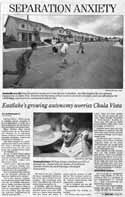What Civic Life Offers Journalists
Throughout this work, you will want – indeed need – to refer to the Harwood Civic Life Frameworks in this section. They provide the foundation for tapping into a community’s civic life and mapping it.
1. Seeing the layers of civic life
Communities, neighborhoods, topics and groups are made up of many layers. There are the five layers of civic life that you will want to explore and understand. They can be applied to the different areas/topics you map.
2. Identifying types of community leaders
Often “leaders” are primarily thought to be elected officials, but within a community (area/topic) there are at least five types of leaders. It is important for you to engage all types of leaders when tapping into a community’s civic life.
3. Engaging people differently
Tapping into a community’s civic life is about more than showing up at new places and talking to people. You need to engage people to gain a deep understanding of their lives, concerns and how they relate to community life.
4. Making sense of different areas
Most neighborhoods or communities or topics are different in many ways (e.g., history, the people, concerns) and present journalists with different challenges.
>> Keep in Mind <<
When reviewing each of the frameworks on civic life, think about the following questions. At some point, it is a good idea to bring together the people involved in mapping a community to have a conversation about their thoughts and reactions to these questions in relation to the civic frameworks.
- When thinking about each of these frameworks, how can they help you do your work?
- Try to fill in the frameworks based on what you know and think about how the insights relate to your work. What happens?



“We learned in civic mapping to evaluate and be able to articulate how a community gets things done. What’s the leadership like? To whom do people turn with problems? Who gets things done?
In a suburban development like Eastlake, the answers to those questions turned out to be interesting enough to be a story on its own. In Eastlake, City Hall is the last place people turn for help. They are much more likely to turn to the housing developer.”
– Karen Lin Clark
South County Editor, The San Diego Union-Tribune
